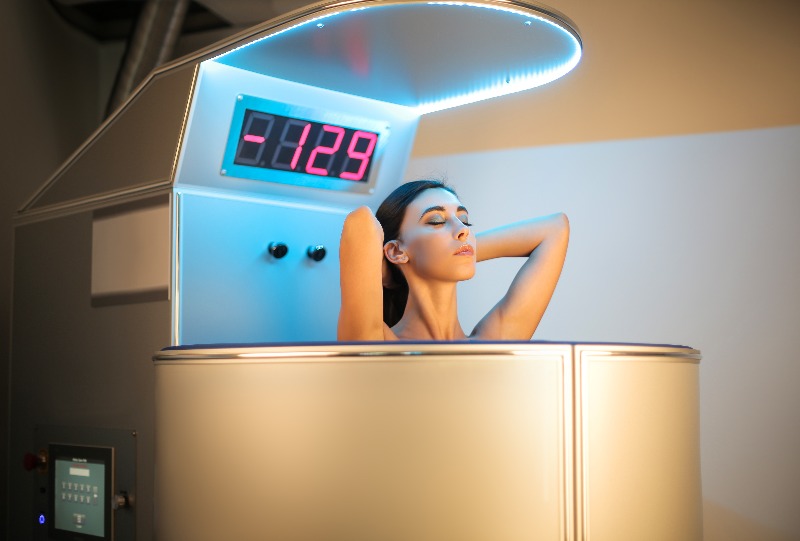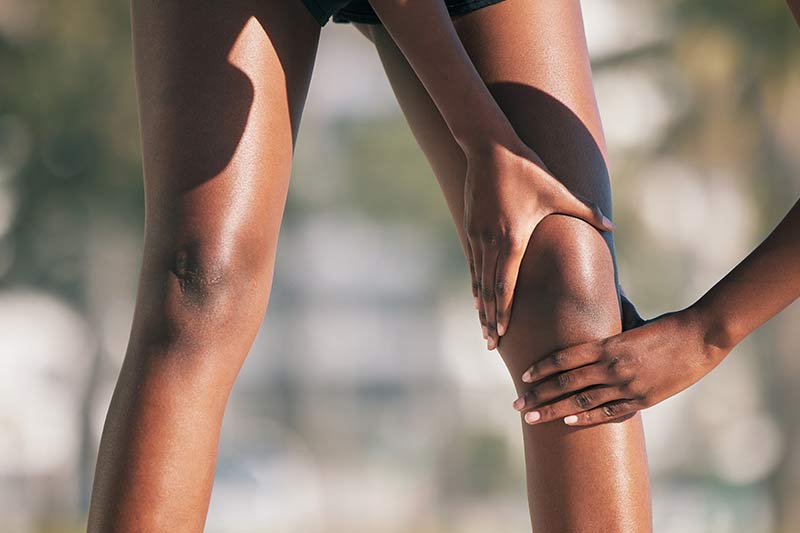Cryotherapy is a method of treating a medical condition by exposing the body to extremely low temperatures. The innovative cold therapy method called whole-body cryotherapy is rapidly gaining momentum worldwide. However, there are few proven benefits, and the FDA warns people to use caution when opting for this treatment.
This article lists eleven cryotherapy benefits and explores potential risks and safe alternative treatments.

Potential Cryotherapy Benefits
Cryotherapy is touted as beneficial for various medical conditions, from sports injuries to dementia. There have been several studies in the past that confirm the healing potential of cryotherapy. However, no comprehensive study has been conducted yet, as this method only recently became popular for its healing properties.
Here are the benefits observed by scientists, cryotherapy providers, and patients.
1. Aids the Treatment of Skin Conditions
Cold therapy may reduce inflammation, minimize oxidative stress, and improve blood circulation. It can treat skin lesions, warts, and skin tags, improves overall complexion, and enhances skin quality.
Cold therapy has been used in medicine for skin conditions since the 19th century. Doctors used liquid air, liquid oxygen, carbon dioxide, and liquid nitrogen to treat warts, herpes zoster, skin cancers, and other skin diseases.
2. Reduces Signs of Aging
Localized cryotherapy is also gaining popularity as an anti-aging treatment. User experience shows facial cryotherapy sessions speed up cell turnover (shedding dead skin cells and creating new cells), increase collagen production, tighten sagging skin on the face and neck, and prevent premature skin aging.
3. Promotes Weight Loss
Cryotherapy can burn 500-800 calories in several minutes. The body is exposed to extreme changes in temperature, from normal to freezing, and the organism works hard to keep the body warm. This increase in energy expenditure can burn extra calories. Cryotherapy sessions, in combination with regular exercise and healthy dieting, may promote weight loss.
4. Reduces Inflammation
Some clinical trials suggest that whole-body cryotherapy increases the production of anti-inflammatory proteins and decreases pro-inflammatory cytokine levels, reducing inflammation.
The anti-inflammatory effect is explained through vasoconstriction at the muscular level. When the body is subjected to freezing temperatures, the blood vessels constrict, and less blood flows to the inflamed area, temporarily numbing the pain.
5. Alleviates Migraine
Limited research and anecdotal evidence show that cold therapy can reduce migraine symptoms, especially if the therapy is applied at the onset of symptoms. The logic behind it is that freezing temperatures cool down the blood passing through the neck arteries to the head, reduce inflammation, and numb migraine pain.
6. Reduces Pain
Cryotherapy can alleviate post-surgical pain and discomfort and help the body recover from sports injuries (trauma, muscle overuse). When blood vessels constrict at low temperatures, the decreased blood circulation temporarily numbs the sensation of pain. Cryotherapy shows promising results in reducing chronic pain, including arthritis and rheumatoid arthritis, but more research is needed to corroborate this claim.
7. Improves Joint Mobility

Whole-body cryotherapy is also showing great potential in treating painful joints. Some of the most common causes of painful joints and issues with joint mobility are arthritis and sports injuries. Apart from shots and surgery, joint disorders are successfully treated with localized cold therapy that provides temporary pain relief.
8. Helps with Mood Disorders
A randomized control study from 2020 looked at 92 adults diagnosed with depressive symptoms who were exposed to ten cryotherapy sessions. Researchers found evidence that whole-body cryotherapy helps with mood disorders, especially depression, and can improve the patient’s quality of life. This is because when exposed to freezing temperatures, the body produces increased levels of adrenaline and endorphins (“happy hormones”). However, these effects are short-term and do not guarantee a permanent solution.
Note: Learn how cryotherapy differs from ice baths, and how the two treatments help enhance mood.
9. Reduces Oxidative Stress
Scientists believe that oxidative stress plays a crucial role in the development of many diseases, such as multiple sclerosis, Alzheimer’s, Parkinson’s, and chronic kidney disease. Since cryotherapy produces antioxidant responses in the body, it may help mitigate oxidative stress linked to numerous medical conditions.
10. May Prevent Dementia and Alzheimer’s Disease
Since it is believed that oxidative stress and inflammatory responses trigger Alzheimer’s, and cryotherapy is thought to reduce oxidative effects and inflammation, it may present a powerful way to prevent this debilitating disease. Anecdotal evidence thus far shows improvement in patients’ cognitive functions and memory after cryotherapy.
11. Helps Treat Low-Risk Tumors
Cryotherapy is an established medical practice for removing different types of tumors, from skin warts to precancerous conditions of the cervix. Skin tumors are treated locally, and internal tumors are treated with cryosurgery.
Is Cryotherapy Safe?
Prolonged exposure to freezing conditions can damage your skin. Whole-body cryotherapy (WBC) carries greater risks because it subjects your body to extremely low temperatures. It is particularly unsafe for patients with an underlying medical condition.
Potential risks of cryotherapy include the following:
- Frostbite – Prolonged exposure to low temperatures can lead to mild frostbite and permanent tissue damage.
- Discomfort, shivering, or dizziness – Depending on your health condition and cold tolerance, you may experience any of these during or after a WBC session.
- Headache – Cryotherapy advocates claim the treatment effectively reduces migraines and neck pain. However, a study showed that whole-body cryotherapy induced reversible cerebral vasoconstriction syndrome, a neurological condition accompanied by splitting headaches.
- Rash (cold panniculitis) – The cold may damage the fatty tissue beneath your skin, forming small bumps or scaly patches. The rash may appear days after whole-body cryotherapy and can take weeks to heal.
- Cerebral bleeding – A reported case involved a 61-year-old woman treated with cryotherapy for psoriatic arthritis.
- Sudden and temporary memory loss – A case of a 63-year-old male shows that WBC can lead to transient global amnesia, although the evidence is inconclusive.
- Urticaria – A controlled trial showed that cryotherapy can be a risk factor for urticaria or hives.
- Suffocation – The FDA warns that WBC may cause asphyxiation (suffocation), especially when liquid nitrogen is used for cooling.
The FDA has not approved any whole-body cryotherapy (WBC) equipment for safety or efficacy and has not cleared any of the devices for medical treatment. Moreover, cryotherapy can worsen the following health conditions:
- Heart disease
- High blood pressure
- Poor blood circulation
- Lung disease
- Cold-triggered allergy
- Neuropathy in the legs
Discuss potential complications, risks, and benefits of cryotherapy with your doctor, especially if you are pregnant, breastfeeding, or have an underlying medical condition.
Cryotherapy Alternatives
Numerous cosmetic treatments and procedures can provide similar health benefits and help you attain your beauty goals. You can avoid potential complications associated with whole-body cryotherapy with the following alternative options.
Light Therapy
Red light therapy (RLT) involves using a laser or LED device emitting red and near-infrared light to improve the skin on a cellular level. It can help you achieve the following goals:
- Minimize wrinkles
- Lose weight
- Fight acne
- Reduce inflammation
- Heal wounds
- Repair muscles and tissues
- Increase collagen and elastin production
Note: Learn about the differences between collagen and elastin.
Lymphatic Drainage Massage
A lymphatic drainage massage involves gentle, rhythmic movements and light pressure that stimulate the lymphatic flow to remove excess fluid, toxins, and waste. This skin-rejuvenating treatment offers the following benefits:
- Reduced fluid retention
- Reduced swelling
- Improved circulation
- Stress relief
- Deep relaxation
- May boost immunity
- May help alleviate eczema
- May reduce cellulite
CoolSculpting and Cooltone
CoolSculpting is an FDA-approved cosmetic treatment based on cryolipolysis, a method that uses cold temperatures to freeze fat deposits on the thighs, arms, flanks, back fat, stomach, buttocks, and chin.
This non-invasive fat-freezing technology can help you achieve the following:
- Targeted fat reduction
- Tighter skin
- Even skin texture
- Smoother contours
- Improved elasticity
- Reduced cellulite (not a guaranteed result)
Cooltone is a muscle-toning cosmetic solution ideal for physically active individuals who want to tighten and strengthen their existing muscles. Since it is not a weight loss treatment, it is best suited for people looking to firm and tone their abdominal muscles, buttocks, and thighs.
Note: Compare CoolSculpting vs. Cooltone to learn how to use them to achieve your aesthetic goals.
Rejuvenating Facial Treatments
Facial treatments enhance skin health and address various skin conditions. They help cleanse the pores, remove excess sebum, hydrate, and nourish all skin layers.
- Oxygen facial - A wand-like device uses high-pressure air to exfoliate dead skin cells and infuse the skin with hydrating serums, resulting in plumper and smoother skin.
- HydraFacial - A medical-grade device unclogs pores and deeply hydrates the skin using potent moisturizing serums. This facial effectively eliminates toxins and brightens the complexion.
- Laser resurfacing – The laser device stimulates collagen, remodels the skin and treats spider veins, acne scars, blemishes, warts, fine lines and wrinkles, and hyperpigmentation.
Note: Learn how Oxygen Infusion and HydraFacial treatments differ and what results to expect.
Weight Loss Therapy
Medical weight loss is a medically supervised program tailored for patients who want to lose excess weight, get back in shape, and start a healthy lifestyle. This doctor-assisted program can help you:
- Achieve your ideal weight
- Maintain an optimal BMI
- Adopt a balanced diet
- Tailor an exercise regime
- Choose metabolism-boosting supplements
Conclusion
Cryotherapy is an innovative healing method that may provide numerous health benefits but is not well-researched and lacks conclusive scientific backing. There are many alternative solutions worth considering that may provide the same or better results. You can rejuvenate the skin, reduce inflammation, and attain your ideal weight with the safe and effective cosmetic and medical treatments listed in this article.
For more information on this topic, reach out to our friendly Vibrant Skin Bar team.


